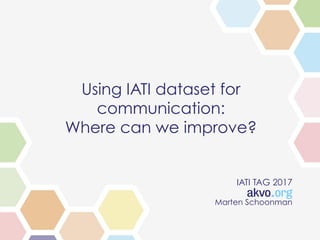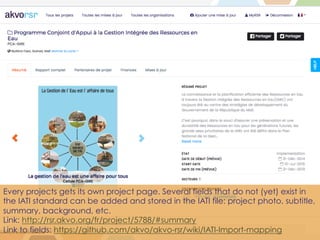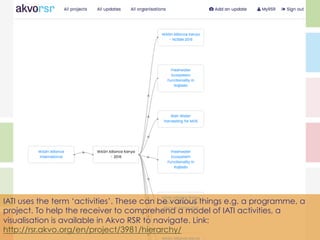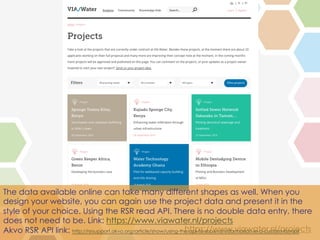Using IATI datasets for communication: Where can we improve?
- 1. Using IATI dataset for communication: Where can we improve? IATI TAG 2017 Marten Schoonman
- 2. Sender Receiver Communication between people: in a simple representation there is a sender and a receiver of a message (content). They interact with each other.
- 3. Sender Receiver They may be far apart; different countries, languages, contexts.
- 4. Sender Receiver So how do they overcome barriers of communication? They interact and there is an emphasis for the sender to make sure the receiver can understand the interaction (e.g. provide translations of content and think about suitable format and channel).
- 5. Linking to IATI: left is the XML format. It is machine-readable and technical people will most likely understand how to convert it. But over 90% of the people wanting to understand this do not understand and will not be able to use it (i.e. no communication). On the right the human-accessible version of the same content. For attractiveness photos and such are added.
- 6. 1.? Enter 2.? Publish 3.? Use: Report, Review, Share, Promote, Collaborate, etc. 4.? Update Sender Receiver When the Sender shares project data there are various steps involved to make communication with IATI data work in order for the receiver (and the sender itself) to understand and use it.
- 7. Akvo is a not-for-profit foundation that creates open source, internet and mobile software and sensors
- 8. Working with xml is not needed to share project data in IATI format. This is a screenshot of the first section of the Akvo RSR project editor. The user is guided along the way to make data entry and updating as simple as possible. Link: http://rsrsupport.akvo.org/article/show/adding-a-new-project-via-the-project-editor
- 9. Immediately after data entry, the data is available on the publicly accessible platform. The entry user can check if all data is entered correctly and adapt it at any time. Link: http://rsr.akvo.org/
- 10. Of course it is possible to customise the project selections and filters to a specific need (organisation, programme, country, etc). This is for example the project portfolio of Plan Finland which has itĪ»s own website link: http://planfinland.akvoapp.org
- 11. Every projects gets its own project page. Several fields that do not (yet) exist in the IATI standard can be added and stored in the IATI file: project photo, subtitle, summary, background, etc. Link: http://rsr.akvo.org/fr/project/5788/#summary Link to fields: https://github.com/akvo/akvo-rsr/wiki/IATI-Import-mapping
- 12. Additional communication options are the ability to add project updates to projects consisting of a photo or video and a text. Over 16,000 updates have been placed online with Akvo RSR this way. Link: http://rsr.akvo.org/en/project/2359/update/16949/
- 13. Sharing results data is of upmost importance. It allows for evaluation and improving aid effectiveness: the essence of the IATI initiative. Elaborate and complex results frameworks can be shared in a readible and attractive manner. Link: http://planfinland.akvoapp.org/en/project/3077/#results,18799,13105
- 14. In extension it can be wise to create custom visualisations for your work to ensure the receiver can easily understand the results structure. Link: http://wash-alliance.org/results/results-visualisation/
- 15. The same can be used to create clarity how (in this case) 100 implementing organisation contribute to the main objective of the programme. It was also shared in poster print with the respective organisations. Link: http://wash-alliance.org/results/results-framework/
- 16. IATI uses the term Ī«activitiesĪ». These can be various things e.g. a programme, a project. To help the receiver to comprehend a model of IATI activities, a visualisation is available in Akvo RSR to navigate. Link: http://rsr.akvo.org/en/project/3981/hierarchy/
- 17. Webpages are one way to communicate project data. Mostly we use reports; printed, in pdf format etc. They cost a lot of time and energy to create. And they are usually share long after work is done. Why not use updated project data to create them using a template? That takes 2 minutes.. Report templates can be added on request. Link: http://rsrsupport.akvo.org/article/show/export-reports-in-my-reports
- 18. Project reports | Project portfolios | Progress reports | Results data in Excel | Annual plans | Annual reports | Mid-term reports | Project references | Storytelling | etc. Many different types of reports can be created this way.
- 19. https://www.viawater.nl/projects The data available online can take many different shapes as well. When you design your website, you can again use the project data and present it in the style of your choice. Using the RSR read API. There is no double data entry, there does not need to be. Link: https://www.viawater.nl/projects Akvo RSR API link: http://rsrsupport.akvo.org/article/show/using-the-api-to-show-rsr-information-in-a-custom-format
- 20. And a screenshot of the custom designed project page Link: https://www.viawater.nl/projects/sponge-towns-kitui-kenya
- 21. Promotion of the data to ensure you reach your constituency of receivers. This can be done via for example using a default web banner to place on another (high traffic) website. Link: http://planfinland.akvoapp.org/en/project/3077/widgets/
- 22. Project updates can be share via Twitter, Facebook, Instagram, etc. Link: https://twitter.com/DorothyMwambazi/status/833050929129725952
- 23. Schema Implementing IATI for communication required careful systems design including dataflow and procedures. Here a diagram of what this can look like. Let us know if you want to talk about this more. Link: marten@akvo.org
- 24. Thank ?you ? ? marten@akvo.org ?
























